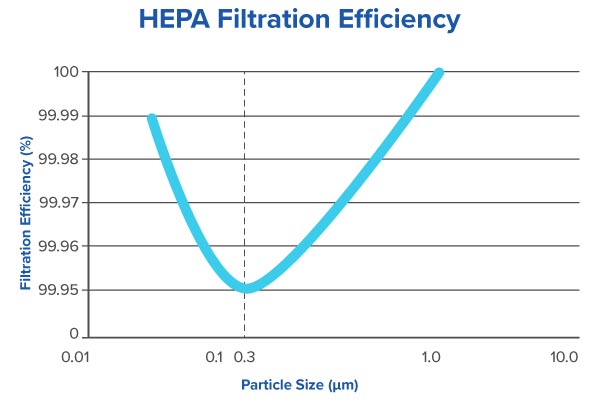Share this
Energy Efficiency: Cost-saving Safety Air Filtration For Schools
by HEPACART on Dec 26, 2023

As students prepare to make their way back to the classroom after the bustling holiday season and the start of a new year, they’re bringing with them more than just notebooks and pencils. This time of year, germs and viruses can run rampant in enclosed spaces — like classrooms, libraries, and dining halls. Especially as temperatures dip lower and lower, students are spending more time indoors, making the job of keeping students, faculty, and staff healthy and safe more challenging.
As we head “back-to-school” this January, how can you prioritize health, cost-effectiveness, and energy efficiency in the classroom? Air filtration — along with high-quality machinery to make it happen — offers great value for schools and educational institutions and can keep everyone inside safe and healthy through cold and flu season and beyond.
Breathing Easy in the Classroom
When we think about getting “fresh air,” we typically think about opening a window or going outdoors. There is good reason for this, as indoor air quality can be 2-5x more contaminated with pollutants, sometimes even as much as 100x more polluted. While these contaminants may not always be visible to the naked eye, they can silently wreak havoc in enclosed indoor spaces. These airborne pollutants can be blamed for all kinds of symptoms including coughing, sneezing, headaches, allergic reactions, asthma attacks, and more. These kinds of reactions can be particularly hard on students or staff who may be extra sensitive to air quality or common airborne allergens. For example, those who have asthma — roughly 1 in 13 students according to EPA estimations — are more likely to have difficulty in a more polluted environment and can even experience decreased cognitive function when air quality is left unchecked.
What Causes Poor Air Quality?
Even the otherwise cleanest schools can be guilty of poor air quality, but what causes it in the first place? You may be surprised at some of the very commonplace factors that can lead to poor air quality over time.
HVAC Systems
Many school buildings have been around for decades, and the simple fact is that these facilities were not designed with their current capacity in mind. What this means for air quality is that the original HVAC units, ductwork, and ventilation systems are not able to provide adequate air exchange and airflow for the number of occupants inside the building. Even though individual AC units may have been replaced over time, often the infrastructure has not. In many cases, this can lead to poor air quality from air simply stagnating for too long.
Students and Faculty
It’s no secret that people — wherever they may be — are the ultimate carrier for germs and bacteria. From simply breathing to shaking hands, hugging, playing, and just existing in the same space together, potential infection can be spread easily with the large numbers of people that are in and around schools. This can make air quality tricky to control, as students, faculty, and staff are constantly moving from one area to another and taking airborne particles, dust, and germs along with them.
Off-gassing
When a school uses certain cleaning products or low-quality materials, chemicals can evaporate from the surface and contaminate the air. This is called off-gassing. It can even happen because of construction projects or renovations. Have you ever opened a new rug, for example, and noticed a strong chemical smell? That could have been an instance of off-gassing. This can happen with new installations of carpet, vinyl flooring, and other new materials that may slowly “air out,” releasing chemicals into the air.
Old Buildings
Aging buildings can cause more trouble for indoor air quality than just ventilation problems. If the building or infrastructure are old enough, you may run into more issues. For example, water damage is common in older buildings, as are Asbestos, mold, dust, and construction debris that can trigger negative reactions from those who breathe in the resulting contaminants.
Making Cents of Clean Air in Schools
Maybe you’re already aware of the dangers and potential threats of poor air quality in schools, but are concerned about the cost to remedy the situation. Many schools these days are working with a tight budget, but air quality doesn’t have to be unaffordable.
Depending on the type and caliber that you are looking for, our air purifiers can run as low as $675, and can last 10 or more years if properly maintained and serviced. To see the best possible performance, you will want to replace your filters regularly, which is typically every three to six months. High-efficiency Particulate Air, or HEPA, filters run about $10 per filter. So, over the ten-year lifetime of your filter, you’re looking at an average of $87.50 per air purifier each year to keep the air clean and safe inside of your school.
Let’s break that number down:
1 HEPACART® air purifier can run as low as $675.
That 1 air purifier can last your facility 10 years.
$675 over 10 years comes out to an average of $67.50 per year.
Add the cost of air filters ($10 every 6 months), and you’re looking at an additional $20 annually.
In total, an average of $87.50 per year, per air purifier for safer air in your facility.
Best Practices for School Air Purifiers

You know that you need to implement air filtration into your school, but there are a few best practices that can help you get the most from your facility’s investment.
Know the Size You Need
Choosing the right size air purifier is crucial for classrooms to achieve optimal air quality. Air purifiers come in various sizes corresponding to the room area they can effectively clean—small purifiers for up to 299 sq ft, medium for 300-699 sq ft, and large for 700-1,900 sq ft. It's essential to match the purifier size to the room to ensure cleanliness throughout the space.
Consider Noise Level
The operational noise of an air purifier can impact student concentration and performance. While searching for classroom air purifiers, selecting one with a quiet mode feature can be beneficial, reducing distractions and aiding in maintaining a productive learning environment.
Budget for Cleaning and Maintenance Costs
Regular maintenance is necessary for air purifiers to function efficiently, with the replacement frequency of HEPA filters dependent on the indoor air quality. Filters typically need changing every 6 months to a year, but this can vary. Some models indicate when a replacement is needed, aiding in maintenance planning and cost management.
Certifications and Warranties
Certifications can indicate an air purifier's quality, showing they meet certain industry standards after rigorous testing. When purchasing, we recommend considering warranties that protect against defects or premature failure.
Powerful Features to Look For

All air purifiers aren’t created equally. With these features at your fingertips, you can confidently expect a higher level of indoor air quality and safety for your school.
HEPA Filters: These remove at least 99.97% of particulates as small as 0.3 microns, including allergens and bacteria.
Air Change Per Hour (ACH): The rate at which fresh air replaces indoor air, with an ACH of 5-6 recommended for schools.
Clean Air Delivery Rate (CADR): This metric indicates the efficiency of air purification, with a higher CADR signifying quicker and more effective filtration.
Clearing the Air: A Commitment to Health in Education
Each school's needs will differ, but the goal is the same no matter who you are — a safe, clean, breathing environment for everyone. Investing in the right air purification system is not only a step towards enhanced health and productivity but also a reflection of your school's commitment to its occupants' well-being.
As you navigate the process of selecting and maintaining the ideal air purifier for your classrooms, don't miss out on our comprehensive guide, "6 Ways to Safeguard Air Quality in Classrooms & Schools.” It's designed to assist you in crafting a practical approach to achieving excellent indoor air quality and energy efficiency. We encourage you to download a copy and build your own strategic path to cleaner, safer air in your educational institution.

